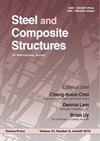圆形钢管混凝土柱震后防火性能的试验与数值研究
IF 3.9
3区 工程技术
Q1 CONSTRUCTION & BUILDING TECHNOLOGY
引用次数: 2
摘要
地震后火灾是一种常见的灾害,给基础设施带来严重的安全问题。本文研究了圆形钢管混凝土柱在震后火灾作用下的剩余承载能力。试验程序包括两个加载步骤-室温预损伤循环加载和恒定压缩加载的瞬态试验。建立了三种有限元模型,并根据试验结果进行了验证。验证后,参数化研究共生成48个数值结果,研究钢管厚度和强度、轴压比和损伤程度对CFST圆形柱耐火性能的影响。在对试验结果和数值结果进行分析的基础上,探讨了圆形钢管混凝土柱的受力机理。提出了不同地震预损伤和压缩载荷下的耐火时间预测设计方法。将新方法的预测结果与新生成的实验和数值结果进行了比较,发现新方法的预测结果准确,与接近1的平均值一致,变异系数在1%左右。本文章由计算机程序翻译,如有差异,请以英文原文为准。
Experimental and numerical investigation on post-earthquake fire behaviour of the circular concrete-filled steel tube columns
Post-earthquake fire is a common disaster which causes serious safety issues to infrastructures. This study aims to investigate the residual loading capacities of circular concrete-filled steel tube (CFST) columns under post-earthquake fire experimentally and numerically. The experimental programme contains two loading steps - pre-damage cyclic loading at room temperature and transient state tests with constant compression loads. Three finite element models are developed and validated against the test results. Upon validation, a total of 48 numerical results were generated in the parametric study to investigate the effects of thickness and strengths of steel tube, axial compression ratio and damage degree on the fire resistance of circular CFST columns. Based on the analysis on experimental and numerical results, the loading mechanism of circular CFST columns is discussed. A design method is proposed for the prediction of fire resistance time under different seismic pre-damage and compression loads. The predictions by the new method is compared with the newly generated experimental and numerical results and is found to be accurate and consistent with the mean value close to the unity and a coefficient of variation around 1%.
求助全文
通过发布文献求助,成功后即可免费获取论文全文。
去求助
来源期刊

Steel and Composite Structures
工程技术-材料科学:复合
CiteScore
8.50
自引率
19.60%
发文量
0
审稿时长
7.5 months
期刊介绍:
Steel & Composite Structures, An International Journal, provides and excellent publication channel which reports the up-to-date research developments in the steel structures and steel-concrete composite structures, and FRP plated structures from the international steel community. The research results reported in this journal address all the aspects of theoretical and experimental research, including Buckling/Stability, Fatigue/Fracture, Fire Performance, Connections, Frames/Bridges, Plates/Shells, Composite Structural Components, Hybrid Structures, Fabrication/Maintenance, Design Codes, Dynamics/Vibrations, Nonferrous Metal Structures, Non-metalic plates, Analytical Methods.
The Journal specially wishes to bridge the gap between the theoretical developments and practical applications for the benefits of both academic researchers and practicing engineers. In this light, contributions from the practicing engineers are especially welcome.
 求助内容:
求助内容: 应助结果提醒方式:
应助结果提醒方式:


